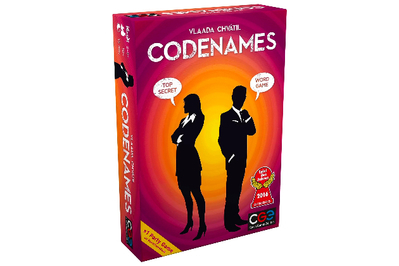If Wordplay Is Your Jam, You’re Gonna Love Codenames
I come from a family of word-game lovers.
My mom will forgo an afternoon at the beach to play a game of Scrabble. If I won’t comply, she’ll settle for a few rounds of Big Boggle. My aunt is so good at Bananagrams that she has to start with a disadvantage, or you never have a chance. And don’t try to propose to any frustrated family member of mine, crouched over the computer at midnight, to just go to bed instead of obsessing over being crowned a Spelling Bee “genius.”
As a writer, I’m on board with word games in principle, but in practice, there’s a teensy-weensy problem: I’m a horrible speller. I try to console myself with the quote, “I don’t give a damn for a man who can spell a word only one way” (often attributed to Mark Twain), but, unfortunately, creative spelling isn’t a real point generator.
Turns out, I’m less interested in the letters inside of words than the connotations that sprawl beyond them. I like the way words diverge and converge with each other in a seemingly endless web, the way you can look at each one like an object with distinctly different sides.
Lucky for me, the word-game genre is not limited to search-and-find and spelling skills. The world learned this when The New York Times released its wildly popular word-affiliation game, Connections, and I learned it nearly a decade ago when Codenames became a family board-game staple.
Although Connections and Codenames have a lot of similarities — they’re both wordplay games that involve corralling words into categories — Codenames is a physical party game of communication that involves both creating categories and guessing what words are in them. While Connections is great for a daily dose of solo wordplay, Codenames is ideal for dinner parties, holidays, or game nights. (Our board-game testers agree — we’ve recommended Codenames since 2018.)
Here’s how the loosely spy-themed game works. To start, set up a grid of 25 one-word cards and then split into two teams and choose a spymaster for each team. The spymaster then provides one-word clues, followed by the number of cards on the grid that the clue applies to. For example, the spymaster might say “baseball, 3” as a clue, in hopes that their team will guess the following three words on the grid: “diamond,” “bat,” and “team.”

The goal is to locate your team’s words without hitting the assassin word, which causes you to lose the game immediately. Only the spymasters know which words to hit and avoid, thanks to a secret key card.
The fun of the game is that most of the words on the grid can be read in different ways. If “plate” is the assassin, it would be risky to use the word “baseball” as a clue, but luckily “diamond” can be corralled with other words like “engagement” or “heist,” while “bat” might connect with words like “superhero,” “flying,” or “night.” But even so, how do you convey that connection with a single word?
The task of connecting words gets more difficult as you have fewer and fewer cards left open on the grid. Sometimes you have to take a chance on an out-there clue to connect two final and wildly different words and beat your opponent. (In one recent game, with just a few words remaining for my team, I tried to connect “hammer” and “tip” with the word “peen.”)

As the spymaster, it’s important to consider the perspective of the guessers on your team. What associations will they have with a certain word? Will they be tuned in to a specific reference based on their interests, or will it be out of their purview completely?
The game is lively as your team discusses the clue and which words might apply; the spymaster is sweating it out as players linger over deadly assassins.
A word-focused brainteaser game is right up my alley, but it isn’t for everyone or every situation. If words aren’t a person’s forte, they can feel left behind. Luckily, the spymaster is the only player under particular pressure. And even I have a hard time playing as spymaster on a day when I’m feeling slow (after a long day at work and a beer, for example).

Despite the brand’s claim that the game is for two to eight or more players, I think it’s best with four to six players (any more than eight feels quite crowded). Teenagers are up to the challenge, but I think the game is a little too demanding for kids (though older kids may be able to play on a team among other guessers). And while the box claims the game is a quick 15 minutes, for me, it easily takes 30.
My least favorite part of the game: Waiting around for one of the spymasters to come up with a clue.
That’s one reason I’ve become partial to Codenames: Duet, marketed as a two-player version of the game. It includes most of the same components of the original game but has slightly different rules, which allow players to act as both spymaster and guesser. Like all co-op games, you win or lose together.
Codenames: Duet is the best way to play the game with two players, but I also like playing it in teams as a cooperative game. Sometimes I actually prefer it to the original version of the game, because you get to be an active player during every single play.

However, I tend to like co-op games and solo puzzles. If you’re a huge Connections fan, you might prefer the Duet version, even if you’re playing in a group. But if you come to a game for the competition, as many people do, you may find the cooperative version lackluster. (Our board-game expert James Austin prefers the rambunctious nature of the original for team play.)
Codenames is also a pick in several of our gift guides (including our guides to the best gifts for families and the best gifts under $25), and it’s a favorite gift pick among Wirecutter readers. I think it would be an ideal white-elephant exchange or Secret Santa gift, too, because it’s fairly affordable and has mass appeal.
It would also be a terrific housewarming gift. After all, nothing christens a new home quite like a little drama, a little joy, some shouting, some celebrating, and (or is it just in my house?) litigating the meaning of a single word.
This article was edited by Hannah Rimm and Catherine Kast.








